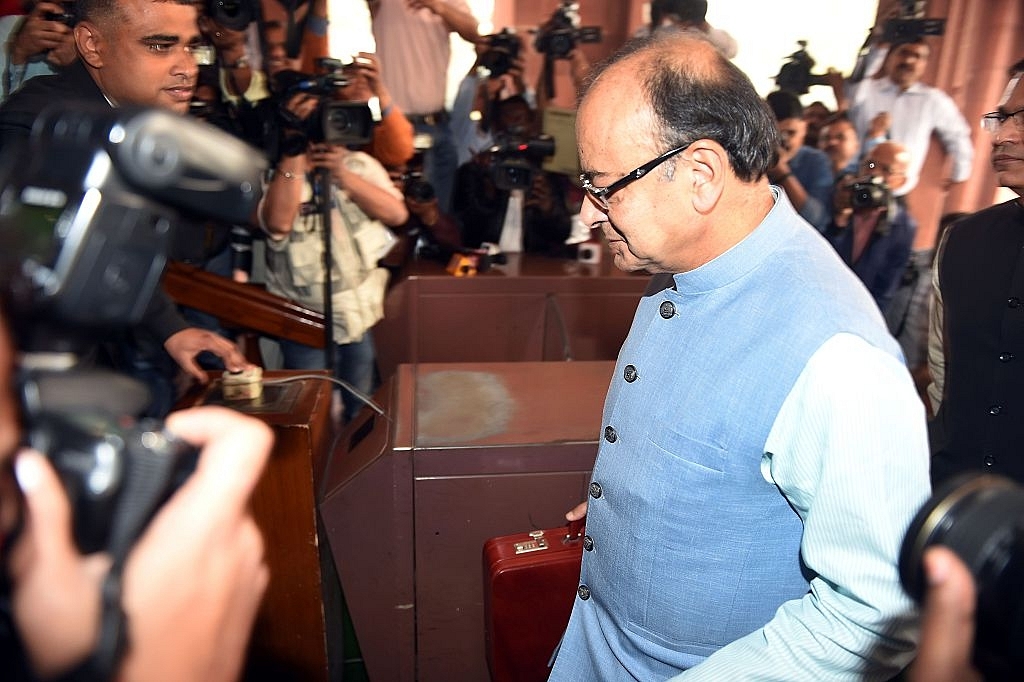Economy
Why Budget 2017-18 Will Be Unique, Maybe The First And Last Of Its Kind
- Five reasons why Budget 2017-2018 will be unique for India.

Finance Minister Arun Jaitley walks past media representatives prior to presenting the Union Budget at Parliament House in New Delhi. (PRAKASH SINGH/AFP/GettyImages)
If one assumes that the Election Commission will not play spoilsport and force a postponement of the Union budget currently scheduled for 1 February, Budget 2017-18 will be the first and the last of its kind.
Several reasons why, and the date change from the normal budget presentation day in end-February to early February is only the most obvious one.
But there are more important reasons why this budget will be unique for India.
First, the date change may only be a precursor to a further bringing forward of the budget date towards the end of the calendar year. This is assuming the Shankar Acharya panel that has been set up to consider changes recommends that the calendar year (or any other period barring the current April-March) should become the financial year. This would call for a budget in October or November. It implies that the ambit of the next budget may be less than a year.
Second, this will be the last budget that will involve so much secrecy. The reason is GST – the goods and services tax, which must be brought into force latest from September this year. Once GST comes into being, indirect tax rates will be set by the GST Council, whose deliberations will not be secret. We will thus know what the rates are even before the budget. The introduction of GST from September means many taxes will change from that date; it implies that we will essentially need a new budget by the end of the year.
There will still be an element of secrecy with direct taxes, but assuming we move towards a steadier tax regime, and index the tax-free income limit (currently Rs 2.5 lakh per annum for individuals) to inflation, even direct taxes will not change year to year. Changes will be few and far between, and even these changes will involve consultations rather than secrecy. A direct taxes code, if it is legislated, will end routine tax changes.
Third, there will be the demonetisation (DeMo) effect to be addressed in this budget. DeMo resulted in a short-term demand compression, and thus some of the measures to revive demand may resemble what the government did post-Lehman. A stimulus is needed and it will come either through tax cuts or other measures.
Fourth, since the distinction between plan and non-plan outlays is being done away with, this time we will get only information on capital and revenue outlays. This is much more meaningful, for the old distinction was an artefact of India’s socialist days. Today, we need to know whether the government will be spending more to boost the productive capacity of the economy (which means capital investment), or merely on self-consumption and freebies. The old assumption that plan spending was good and non-plan bad made no sense, since non-plan spending could involve capital spending, while plan spending may be substantially administrative or consumption oriented.
Fifth, if the next budget is terminated early due to GST and/or changes in the financial year, the NDA government will be presenting two more regular budgets before its term ends. One later this calendar year, and another next year, some months before the election process for the 2019 Lok Sabha elections begins. This implies that the NDA will have presented six budgets (or even seven, if Budget 2017-18 is terminated by September this year) in its five-year tenure.
Introducing ElectionsHQ + 50 Ground Reports Project
The 2024 elections might seem easy to guess, but there are some important questions that shouldn't be missed.
Do freebies still sway voters? Do people prioritise infrastructure when voting? How will Punjab vote?
The answers to these questions provide great insights into where we, as a country, are headed in the years to come.
Swarajya is starting a project with an aim to do 50 solid ground stories and a smart commentary service on WhatsApp, a one-of-a-kind. We'd love your support during this election season.
Click below to contribute.
Latest